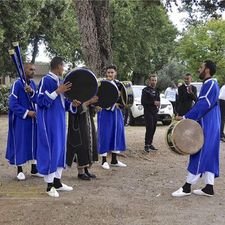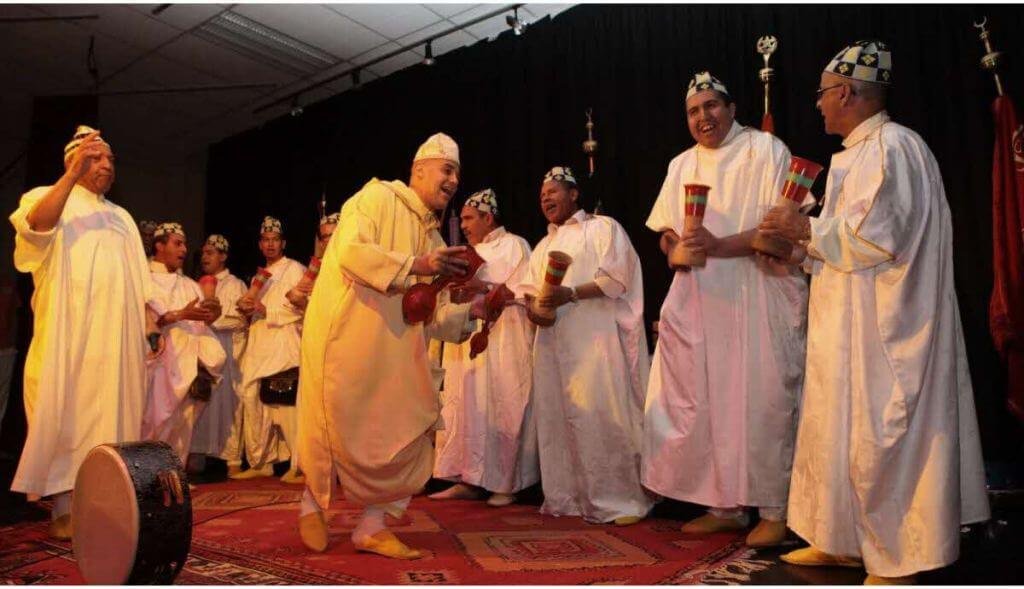Dkaa El Marrakchia: A Popular Folk Music of Morocco
Dkaa El Marrakchia is a popular folk music distinct to Morocco, especially Marrakech. The members of the group have different social statuses. These include shopkeepers, artists and artisans,.etc. Male musicians perform the Dakka, which involves much drumming while maintaining a striking rhythm with hands. The sound is produced when all members of the group clap hands uniformly. It is a unique rhythmic that is correctly defined and mastered.
Dakka is an art that brings joy and entertains the community together. The members of this entertainment group have become accustomed to excelling in Dakka competitions during Ashura’s night. This is to perpetuate this rite so anchored in the city’s heritage.
Med Bellamkaddam (Aka Baba) is One of the most famous leaders of the “Marrakech” group of the “Dkaa.” For years, he led the troupe all over Morocco and worldwide to promote this authentic music.
This folkloric music is well coordinated by its members while performing the Dkaa. In the Taguya (little hat), the singers dress in Djellaba and form a circle or semicircle. The troupe consists of many percussionists who start with songs evoking the city’s saints with all the compliments they deserve. The broad and majestic character of this first phase, led by the percussionist, is somewhat reminiscent of the dances of the Ahwâsh.
The second phase is simple, moderate, and repetitive. It is a preface to modify the rhythm expected during the third and last phase of this Dkaa, called Afoss, which means hand in Berber. The rhythm starts slowly, then accelerates like a cadence.
Male artists create sounding beats on traditional percussion tools. These include the Taarija, Naffar, Lakrakash, and Tara. At the same time, others elevate their voices in choral incantations. The music is unique and attracts the audience like a magnet. This is because of its simplicity and the fun atmosphere it creates. The music boosts and reenergizes the spirit and pays tribute to the saints of Marrakech.
Some Fact about Dkaa El Marrakchia
- This traditional art has existed for centuries. It still occurs once a year, during the “Achoura” Festival. It is an integral part of the cultural heritage dating back to the Saadian dynasty.
- Many say that the Dkaa movement has its origins in Taroudant. It shapes who they are, and it is part of their identity. Some suggest that Dkaa El Marrakchia originates from the imperial city of Marrakech.
- Dkaa Marrakech is mainly highlighted during the religious Festival of “Achoura,” which is celebrated on the tenth day of the Muslim New Year. It is also practiced on many occasions, social events, and ceremonies.
- Dkaa el Marrakchia is considered to be an exclusively male musical genre. Its members come from families of craftsmen, shopkeepers, and artists. It is distinguished by polyrhythmic percussion and choral songs.
- The Festival of Achoura is the privileged time of Dkaa el Marrakchia music. Medina enjoys tambourines, rattlesnakes, and “Neffar,” a long copper horn. This is while each Dkaa el Marrakchia group from each district competes in virtuosity in the Medina alleys before meeting in the Menara Gardens.
The Dkaa flourished in the districts of Marrakech, and craftsmen were the artists of “D’Kaykiya.” One of the goals of playing this folkloric music is to forget the arduousness of their daily routine.
Dkaa el Marrakchia pays tribute to the saints of Marrakech and the area. The region’s spiritual saints are called “Sabaatou Rijal,” seven spiritual people.
The seven spiritual guardians of the metropolis are:
- Qadi Ayad.
- Imam Souhayli.
- Imam El Jazouli.
- Sidi Youssef Ben Ali.
- Sidi Abdelaziz Tabbaa.
- Abou El Abbas Essebti.
- Sidi Abdellah El Ghazouani (called Moul Laksour).
DKaa Marakchia groups demonstrate their capacity to become a single body, stable and united. They have one sole and sacred motto, “one for all and all for one.” Each city district possesses a group of men, and their musical ear distinguishes each group. They can grip the sense of rhythm and have enough energy to raise the sacred leader’s standard to the highest level.
These districts are:
- Casbah.
- Ben Salah.
- Sabtiyyine.
- El Moukkaf.
- Bab D’Bagh.
- Bin Laarassi.
- Derb Dabachi.
Dkaa el Marrakchia is a traditional dance form passed down through generations in the Marrakech region of Morocco. It is deeply ingrained in the country’s historical and cultural heritage and its people. As a testament to its importance, Dkaa el Marrakchia has been integrated into the International Festival of Marrakech, which aims to develop, densify, and diversify the city’s artistic and cultural offerings. By doing so, the festival seeks to benefit locals and visitors alike, creating a vibrant and inclusive space for people from all walks of life. This celebration of art and culture is marked by tolerance and openness to others, making it a truly unique and memorable event in the region.
The Asdekaa Nakhil Association, also known as “Friends of the Marrakech Palm Tree,” organizes a festival every year in February to promote and preserve local folk arts. The festival features diverse events showcasing classical and folkloric music, among other cultural activities.
The festival’s highlight is the performance of Dkaa el Marrakchia, a traditional form of music that has deep roots in the region. The festival aims to ensure that younger generations do not forget the rich cultural heritage of their community. By programming various events, the festival seeks to enhance, preserve, and perpetuate the local folk arts while celebrating the region’s cultural diversity.
The Dkaa el Marrakchia festival organizers have always been committed to actively involving the youth in the festivities. They recognize the importance of keeping the younger generation connected to their cultural heritage, and one way they achieve this is by including them in traditional music performances. This provides an opportunity for the youth to showcase their talents and fosters a sense of community awareness and involvement.
In addition to music performances, the festival organizers integrate various activities such as workshops, exhibits, conferences, and more. These additional offerings make the festival a complete package, providing something for everyone to enjoy and participate in. By doing so, the festival can sustain its status as an important cultural event for years.
Through this inclusive approach, the Dkaa el Marrakchia festival inspires and encourages the youth to stay connected with their heritage. This ensures the festival remains an integral part of the community for generations.


